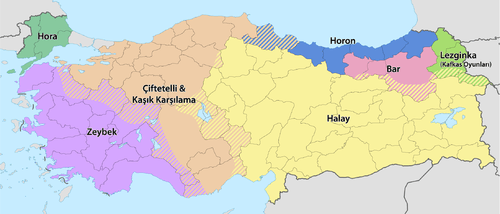Yalli

Halay or Yalli or Dilan (Azerbaijani: Yallı; Armenian: Շուրջպար šurǰpar; Syriac: ܚܓܐ Ḥeggāʾ, Greek: Χαλάϊ Chaláï; Kurdish: Govend or Dîlan, Turkish: Halay, Sakha: Ohuokhai, Persian: هالای "Hālāy") is a popular dance in the Middle East.
Etymology
One source[1] suggests a possible connection of the Turkish halay to alay: a crowd at a parade, or a regiment. The word alay is traced back through Greek ultimately to the Latin ala meaning a wing or a certain military formation with cavalry at the wings.
Style
Halay is traditionally played during wedding on the zurna, supported by a davul, but in the recent years, electronic instruments have started to replace them. Typically, Halay dancers form a circle or a line, while holding each other with the little finger or shoulder to shoulder or even hand to hand with the last and first player holding a piece of cloth. It is a national dance in Azerbaijan and Turkey.
The initial form of which dates back to so many centuries long when it was held around a ceremony bonfire, having the meaning of hot, light and meal. The word “yal” in Azerbaijani means row, line of chain. The Yalli dancers stand in one line or two rows and sometimes in some rows.
See also
- Attan, an Afghan or Pashtun folk dance
- Tamzara, an Anatolian folk dance
- Khigga, an Assyrian folk dance
- Kolo, a South Slavic folk dance
References
- ↑ Sevan Nişanyan, Sözlerin Soyağacı: Çağdaş Türkçenin Etimolojik Sözlüğü (the family tree of words: an etymological dictionary of contemporary Turkish), Istanbul, 2007
| ||||||||||||||||
| ||||||||||||||||||||||||||||||||||||||